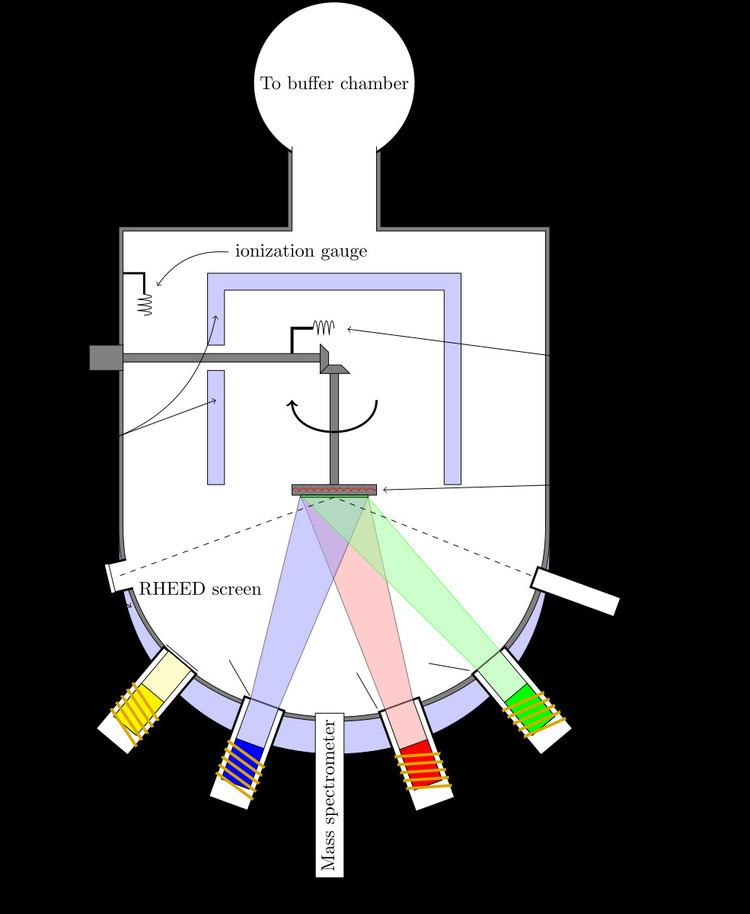 | ||
Molecular beam epitaxy (MBE) is an epitaxy method for thin-film deposition of single crystals. It was invented in the late 1960s at Bell Telephone Laboratories by J. R. Arthur and Alfred Y. Cho. MBE is widely used in the manufacture of semiconductor devices, including transistors for cellular phones and WiFi.
Contents
Method
Molecular beam epitaxy takes place in high vacuum or ultra-high vacuum (10−8 - 10−12 Torr). The most important aspect of MBE is the deposition rate (typically less than 3,000 nm per hour) that allows the films to grow epitaxially. These deposition rates require proportionally better vacuum to achieve the same impurity levels as other deposition techniques. The absence of carrier gases as well as the ultra high vacuum environment result in the highest achievable purity of the grown films.
In solid source MBE, elements such as gallium and arsenic, in ultra-pure form, are heated in separate quasi-Knudsen effusion cells or electron beam evaporators until they begin to slowly sublime. The gaseous elements then condense on the wafer, where they may react with each other. In the example of gallium and arsenic, single-crystal gallium arsenide is formed. When evaporation sources such as copper or gold are used, the gaseous elements impinging on the surface may be adsorbed (after a time window where the impinging atoms will hop around the surface) or reflected. Atoms on the surface may also desorb. Controlling the temperature of the source will control the rate of material impinging on the substrate surface and the temperature of the substrate will affect the rate of hopping or desorption. The term "beam" means that evaporated atoms do not interact with each other or vacuum chamber gases until they reach the wafer, due to the long mean free paths of the atoms.
During operation, reflection high energy electron diffraction (RHEED) is often used for monitoring the growth of the crystal layers. A computer controls shutters in front of each furnace, allowing precise control of the thickness of each layer, down to a single layer of atoms. Intricate structures of layers of different materials may be fabricated this way. Such control has allowed the development of structures where the electrons can be confined in space, giving quantum wells or even quantum dots. Such layers are now a critical part of many modern semiconductor devices, including semiconductor lasers and light-emitting diodes.
In systems where the substrate needs to be cooled, the ultra-high vacuum environment within the growth chamber is maintained by a system of cryopumps, and cryopanels, chilled using liquid nitrogen or cold nitrogen gas to a temperature close to 77 Kelvin (−196 degrees Celsius). Cryogenic temperatures act as a sink for impurities in the vacuum, so vacuum levels need to be several orders of magnitude better to deposit films under these conditions. In other systems, the wafers on which the crystals are grown may be mounted on a rotating platter which can be heated to several hundred degrees Celsius during operation.
Molecular beam epitaxy is also used for the deposition of some types of organic semiconductors. In this case, molecules, rather than atoms, are evaporated and deposited onto the wafer. Other variations include gas-source MBE, which resembles chemical vapor deposition.
In 2009, molecular beam epitaxy has been used to deposit oxide materials for advanced electronic, magnetic and optical applications. For these purposes, MBE systems have to be modified to incorporate oxygen sources.
Asaro-Tiller-Grinfeld instability
The Asaro-Tiller-Grinfeld (ATG) instability, also known as the Grinfeld instability, is an elastic instability often encountered during molecular beam epitaxy. If there is a mismatch between the lattice sizes of the growing film and the supporting crystal, elastic energy will be accumulated in the growing film. At some critical height, the free energy of the film can be lowered if the film breaks into isolated islands, where the tension can be relaxed laterally. The critical height depends on the Young's modulus, mismatch size, and surface tension.
Some applications for this instability have been researched, such as the self-assembly of quantum dots. This community uses the name of Stranski–Krastanov growth for ATG.
